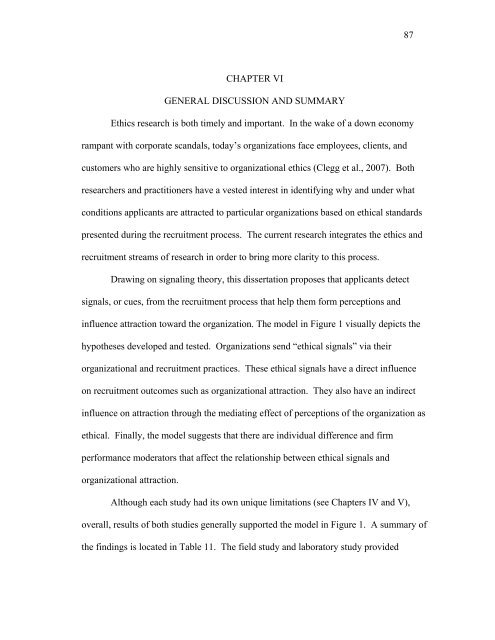THE EFFECT OF ETHICAL SIGNALS ON RECRUITMENT ...
THE EFFECT OF ETHICAL SIGNALS ON RECRUITMENT ...
THE EFFECT OF ETHICAL SIGNALS ON RECRUITMENT ...
You also want an ePaper? Increase the reach of your titles
YUMPU automatically turns print PDFs into web optimized ePapers that Google loves.
CHAPTER VI<br />
GENERAL DISCUSSI<strong>ON</strong> AND SUMMARY<br />
Ethics research is both timely and important. In the wake of a down economy<br />
rampant with corporate scandals, today’s organizations face employees, clients, and<br />
customers who are highly sensitive to organizational ethics (Clegg et al., 2007). Both<br />
researchers and practitioners have a vested interest in identifying why and under what<br />
conditions applicants are attracted to particular organizations based on ethical standards<br />
presented during the recruitment process. The current research integrates the ethics and<br />
recruitment streams of research in order to bring more clarity to this process.<br />
Drawing on signaling theory, this dissertation proposes that applicants detect<br />
signals, or cues, from the recruitment process that help them form perceptions and<br />
influence attraction toward the organization. The model in Figure 1 visually depicts the<br />
hypotheses developed and tested. Organizations send “ethical signals” via their<br />
organizational and recruitment practices. These ethical signals have a direct influence<br />
on recruitment outcomes such as organizational attraction. They also have an indirect<br />
influence on attraction through the mediating effect of perceptions of the organization as<br />
ethical. Finally, the model suggests that there are individual difference and firm<br />
performance moderators that affect the relationship between ethical signals and<br />
organizational attraction.<br />
Although each study had its own unique limitations (see Chapters IV and V),<br />
overall, results of both studies generally supported the model in Figure 1. A summary of<br />
the findings is located in Table 11. The field study and laboratory study provided<br />
87
















